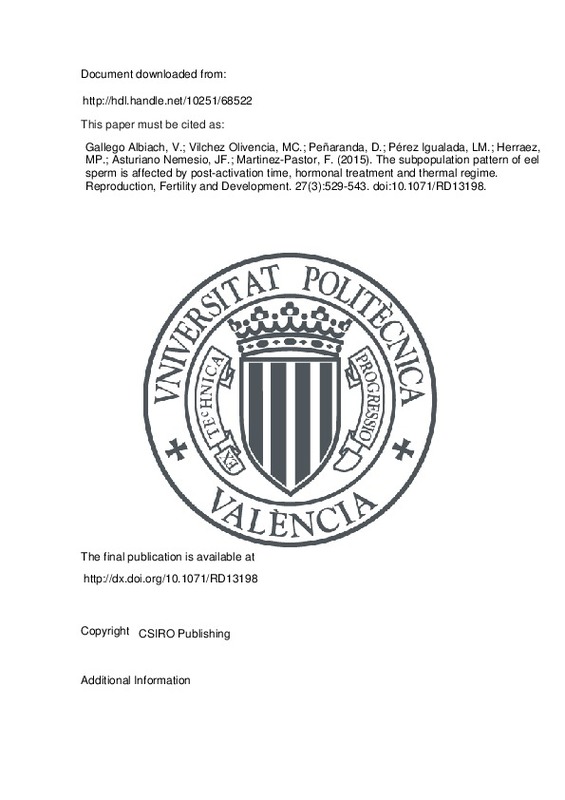JavaScript is disabled for your browser. Some features of this site may not work without it.
Buscar en RiuNet
Listar
Mi cuenta
Estadísticas
Ayuda RiuNet
Admin. UPV
The subpopulation pattern of eel sperm is affected by post-activation time, hormonal treatment and thermal regime
Mostrar el registro sencillo del ítem
Ficheros en el ítem
| dc.contributor.author | Gallego Albiach, Victor
|
es_ES |
| dc.contributor.author | Vilchez Olivencia, Maria Carmen
|
es_ES |
| dc.contributor.author | Peñaranda, D.S.
|
es_ES |
| dc.contributor.author | Pérez Igualada, Luz María
|
es_ES |
| dc.contributor.author | Herraez, María Paz
|
es_ES |
| dc.contributor.author | Asturiano Nemesio, Juan Francisco
|
es_ES |
| dc.contributor.author | Martinez-Pastor, Felipe
|
es_ES |
| dc.date.accessioned | 2016-09-01T10:31:19Z | |
| dc.date.available | 2016-09-01T10:31:19Z | |
| dc.date.issued | 2015 | |
| dc.identifier.issn | 1031-3613 | |
| dc.identifier.uri | http://hdl.handle.net/10251/68522 | |
| dc.description.abstract | [EN] There has been a marked reduction in natural stocks of eels (genus Anguilla) over the past 60 years, and the culture of eels is still based on the capture of very large quantities of juveniles. It is necessary to close the life cycle in captivity in order to ease the pressure on wild populations. The aims of the present study were to evaluate sperm subpopulations (through cluster analysis of computer-aided sperm analysis data) in the European eel (Anguilla anguilla) and to assess the effects of motility acquisition time after activation (i.e. at 30, 60 and 90 s), the thermal regimen (i.e. 10 degrees C (T10) or 15 degrees C (T15) and up to 20 degrees C, or constant at 20 degrees C (T20)) and hormonal treatments (i.e. human chorionic gonadotropin (hCG), recombinant (r) hCG or pregnant mare serum gonadotropin (PMSG)) on these subpopulations. In all cases, we obtained three subpopulations of spermatozoa: low velocity and linear (S1); high velocity with low linearity (S2); and high velocity and linear (S3; considered high quality). Total motility and S1 were affected by acquisition time; thus, 30 s is recommended as the standard time for motility acquisition. When eels were kept at 20 degrees C (T20), motility data fitted quadratic models, with the highest motility and proportion of S3 between Weeks 8 and 12 after the first injection. Lower temperatures (T10, T15) delayed spermiation and the obtaining of high-quality spermatozoa (S3), but did not seem to alter the spermiation process (similar subpopulation pattern). Conversely, the hormonal treatments altered both the dynamics of the subpopulation pattern and the onset of spermiation (with PMSG delaying it). Total motility and the yield of S3 with the widely used hCG treatment varied throughout the spermiation period. However, using rhCG allowed us to obtain high-quality and constant motility for most of the study (Weeks 7-20), and the S3 yield was also higher overall (61.8 +/- 1.3%; mean +/- s.e.m.) and more stable over time than the other hormonal treatments (averaging 53.0 +/- 1.4%). Using T20 and rhCG would be more economical and practical, allowing us to obtain a higher number of S3 spermatozoa over an extended time. | es_ES |
| dc.description.sponsorship | This study was funded by the European Community's 7th Framework Program under the Theme 2 'Food, Agriculture and Fisheries, and Bio-technology', grant agreement no. 245257 (PRO-EEL) and Generalitat Valenciana (ACOMP/2012/086). VG and MCV have predoctoral grants from the Spanish Ministry of Economy and Competitiveness (AGL2010-16009) and Universitat Politecnica de Valencia (UPV) PAID Program (2011-S2-02-6521), respectively. DSP was supported by a contract cofinanced by Ministry of Science and Innovation (MICINN) and UPV (PTA2011-4948-I). FM-P was supported by the Ramon y Cajal program (MICINN, RYC-2008-02560). | en_EN |
| dc.language | Inglés | es_ES |
| dc.publisher | CSIRO Publishing | es_ES |
| dc.relation.ispartof | Reproduction, Fertility and Development | es_ES |
| dc.rights | Reserva de todos los derechos | es_ES |
| dc.subject | computer-aided sperm analysis | es_ES |
| dc.subject | European eel | es_ES |
| dc.subject | motility activation | es_ES |
| dc.subject.classification | BIOLOGIA ANIMAL | es_ES |
| dc.subject.classification | PRODUCCION ANIMAL | es_ES |
| dc.title | The subpopulation pattern of eel sperm is affected by post-activation time, hormonal treatment and thermal regime | es_ES |
| dc.type | Artículo | es_ES |
| dc.identifier.doi | 10.1071/RD13198 | |
| dc.relation.projectID | info:eu-repo/grantAgreement/EC/FP7/245257/EU/Reproduction of European Eel: Towards a Self-sustained Aquaculture/ | es_ES |
| dc.relation.projectID | info:eu-repo/grantAgreement/GVA//ACOMP%2F2012%2F086/ | es_ES |
| dc.relation.projectID | info:eu-repo/grantAgreement/MICINN//AGL2010-16009/ES/MECANISMOS FISIOLOGICOS IMPLICADOS EN LA ESPERMIACION Y EN LA ADQUISICION DE MOTILIDAD ESPERMATICA EN LA ANGUILA EUROPEA (ANGUILLA ANGUILLA)/ | es_ES |
| dc.relation.projectID | info:eu-repo/grantAgreement/UPV//PAID-2011-S2-02-6521/ | es_ES |
| dc.relation.projectID | info:eu-repo/grantAgreement/MICINN//PTA2011-4948-I/ES/PTA2011-4948-I/ | es_ES |
| dc.relation.projectID | info:eu-repo/grantAgreement/MICINN//RYC-2008-02560/ES/RYC-2008-02560/ | es_ES |
| dc.rights.accessRights | Abierto | es_ES |
| dc.contributor.affiliation | Universitat Politècnica de València. Instituto de Ciencia y Tecnología Animal - Institut de Ciència i Tecnologia Animal | es_ES |
| dc.contributor.affiliation | Universitat Politècnica de València. Departamento de Ciencia Animal - Departament de Ciència Animal | es_ES |
| dc.description.bibliographicCitation | Gallego Albiach, V.; Vilchez Olivencia, MC.; Peñaranda, D.; Pérez Igualada, LM.; Herraez, MP.; Asturiano Nemesio, JF.; Martinez-Pastor, F. (2015). The subpopulation pattern of eel sperm is affected by post-activation time, hormonal treatment and thermal regime. Reproduction, Fertility and Development. 27(3):529-543. https://doi.org/10.1071/RD13198 | es_ES |
| dc.description.accrualMethod | S | es_ES |
| dc.relation.publisherversion | http://dx.doi.org/10.1071/RD13198 | es_ES |
| dc.description.upvformatpinicio | 529 | es_ES |
| dc.description.upvformatpfin | 543 | es_ES |
| dc.type.version | info:eu-repo/semantics/publishedVersion | es_ES |
| dc.description.volume | 27 | es_ES |
| dc.description.issue | 3 | es_ES |
| dc.relation.senia | 268999 | es_ES |
| dc.identifier.eissn | 1448-5990 | |
| dc.contributor.funder | European Commission | |
| dc.contributor.funder | Generalitat Valenciana | |
| dc.contributor.funder | Ministerio de Ciencia e Innovación | |
| dc.contributor.funder | Universitat Politècnica de València |







![[Cerrado]](/themes/UPV/images/candado.png)

